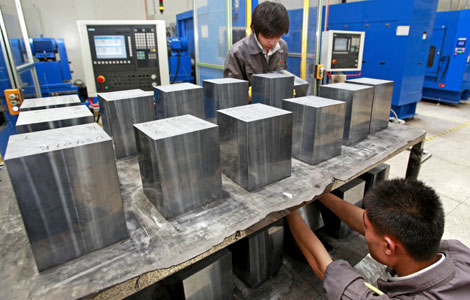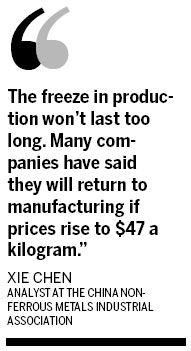Polysilicon production curbed 30%
Updated: 2012-02-17 07:42
(China Daily)
|
||||||||
|
 Quality control employees inspect polysilicon ingots at a production facility in Anyang, Henan province. Polysilicon producers expect an increase in solar panel demand will soak up an excess supply of the raw material. [Wang Zirui / For China Daily] |
Industry to keep facilities idle as prices recover from near-record low
BEIJING - China's polysilicon industry, the biggest supplier to solar-panel manufacturers worldwide, has idled almost one-third of production and may keep the plants closed until prices recover from a 60 percent plunge.
The price tumble spurred the smallest producers including units of Baoding Tianwei Baobian Electric Co and Dongfang Electric Corp to halt plants, according to Xie Chen, an analyst from the China Nonferrous Metals Industrial Association, a trade group that advises the government. China has about 45 percent of global production capacity to purify silicon into polysilicon.
The suspensions may be short-lived because the average spot price for the most expensive ingredient in making solar panels rose by 9 percent since mid-December from a decade low. A recovery would boost margins for the biggest makers such as GCL-Poly Energy Holdings Ltd, China's largest, and Hemlock Semiconductor Corp of the United States, which is No 1 in the world by capacity.
"The freeze in production won't last too long," Xie said in an interview. "Many companies have said they will return to manufacturing if prices rise to $47 a kilogram" from the current level of about $28.80.
Xie forecast prices will jump to $40 to $50 a kilogram this year. That's enough to prompt a return to production in the first half of most of the halted plants, which he estimated were about 30 percent of the total. Xie's view was shared by Lian Rui, a senior analyst in Beijing for New York-based research company Solarbuzz.
Price expectations

Polysilicon will average about $30 this year, and companies including the units of Baoding Tianwei and Dongfang Electric will probably resume production as early as May, Lian said in an interview.
Two phone calls placed to Gong Dan, spokesman for Dongfang Electric, and an e-mail sent to Yin Xiaonan, Baoding Tianwei's spokesman, weren't answered.
The rebound from polysilicon's 10-year low of $26.31 a kilogram in mid-December coincides with increased interest by China to install photovoltaic devices on its own soil.
Chinese producers will double the number of panels that will be installed this year from the 2.2 gigawatts erected in the country in 2011, according to predictions from manufacturers Suntech Power Holdings Co and Trina Solar Ltd. That would absorb some of the industry's excess inventory, which led to the drop in prices and profits.
Demand for solar products is recovering and is expected to shift from Europe to Asian and US markets, Renewable Energy Corp ASA, a Sandvika, Norway-based maker of polysilicon, said in its earnings presentation on Feb 8.
'Suck up supply'
The increase in panel demand in China "sucks up some of the excess supply", Pavel Molchanov, an analyst for Raymond James & Associates Inc in Houston, said by e-mail on Feb 9.
The expectation that China will increase installations this year has led some solar companies to keep plants running. GCL-Poly, LDK Solar Co and Asia Silicon (Qinghai) Co have continued to operate their plants, according to Xie. His association acts as a conduit between the Chinese government and solar companies, advising both ministers and executives.
LDK Solar said in November that it plans to triple its capacity and make 55,000 tons of polysilicon a year by 2014. GCL-Poly more than doubled capacity last year to 46,000 tons. Korea's OCI Co is building a plant capable of making 24,000 tons of the material annually in Saemangeum.
Jessy Fang, a spokeswoman of GCL-Poly in Hong Kong, declined to comment. Two calls to Li Longji, an acting director for LDK's public relations department, weren't answered.
Smaller companies
It is the smaller companies that have struggled and may continue to do so, said Lian of Solarbuzz.
Leshan Ledian Tianwei Silicon Science & Technology Co and Xinguang Silicon, units of Baoding Tianwei, halted production last year to reduce losses and operating costs. Dongfang Electric Emei Semiconductor Material Co, a unit of Dongfang Electric Corp, also stopped manufacturing.
Zhejiang Xiecheng Silicon Industry Co filed for bankruptcy in December, the first collapse of a solar company in China.
"Prices may be stuck near $30 a kilogram for a year or two, but this may be enough for the bigger companies like LDK and GCL to continue with production," Lian said. It's unlikely that the larger companies will seek to acquire those that are struggling, he said. "Buying a company that can't operate efficiently is costlier than expanding organically," he said.
Bloomberg News

 Relief reaches isolated village
Relief reaches isolated village
 Rainfall poses new threats to quake-hit region
Rainfall poses new threats to quake-hit region
 Funerals begin for Boston bombing victims
Funerals begin for Boston bombing victims
 Quake takeaway from China's Air Force
Quake takeaway from China's Air Force
 Obama celebrates young inventors at science fair
Obama celebrates young inventors at science fair
 Earth Day marked around the world
Earth Day marked around the world
 Volunteer team helping students find sense of normalcy
Volunteer team helping students find sense of normalcy
 Ethnic groups quick to join rescue efforts
Ethnic groups quick to join rescue efforts
Most Viewed
Editor's Picks

|

|

|

|

|

|
Today's Top News
Health new priority for quake zone
Xi meets US top military officer
Japan's boats driven out of Diaoyu
China mulls online shopping legislation
Bird flu death toll rises to 22
Putin appoints new ambassador to China
Japanese ships blocked from Diaoyu Islands
Inspired by Guan, more Chinese pick up golf
US Weekly

|

|






